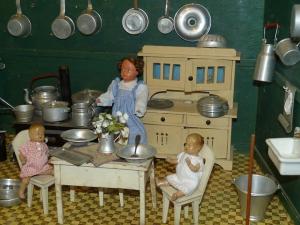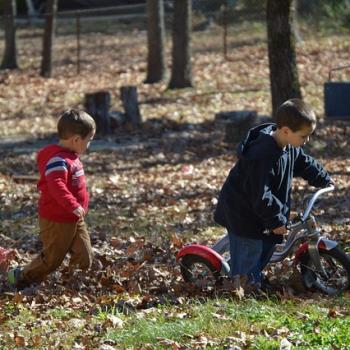
Grandpa made me a dollhouse, the most beautiful dollhouse in the world.
Dollhouses were my favorite toy. I already had a few– one was a classic 80s Fisher Price house, the kind with a doorbell which went “ding!” The other was a Forest Friends vacation house, with a loft for a roof, furnished with mismatched Plamobil furniture. The third was my mother’s old dollhouse, made by my grandfather from a kit a long time ago. I found it in the basement and dragged it up to my bedroom to fill with more Plamobil things. But Grandpa said I should have my own dollhouse, made special just for me.
Besides being the only internist in the small town where he lived and growing an enormous garden, my grandfather was also a self-taught carpenter. Carpentry was what he did when he was off his shifts at the hospital, if it was too dark to garden. He was the kind of person who had to be constantly at work on a complicated project or he’d get nervous. He’d built a playhouse that was tall as the basement ceiling for his daughters to play in– it had windows, a living room and kitchen with cupboards, working porch lights, and a plaque out front with the family name engraved on it. He’d built a second playhouse for my cousins, and a house outdoors that was now being used as a garden shed. He was in the middle of working on a great big church for dolls with a communion rail and a baptismal font– but he’d stopped that project when he decided I needed a dollhouse, and I don’t think he ever finished it. I visualize that lapsed doll church project every time I use the phrase “lapsed Catholic.”
“What kind of dollhouse do you want?” he asked me.
“A big Victorian mansion with a tower,” I answered immediately.
My mother shushed me for being greedy, but my grandfather accepted the challenge at once. He studied books on Victorian architecture to get it just right.
“Now, most of these Victorian mansions had dark formal colors indoors, but they had very light pastel colors on the outside. Would you like that?”
I liked it immensely.
The project took him well over a year. I used to visit him in his basement carpentry studio to watch the progress whenever I came to town.
“Sometimes,” he said happily as he worked, “I get started on this for the evening, I lose track of time, I look up and it’s after midnight.”
Finally, on one of my grandparents’ visits, he brought the dollhouse with him. The whole thing was bolted to an old-fashioned elementary school desk so I could keep it off the floor and store excess furniture. That meant it was over five feet tall, and at first I had to stand on a chair to see the roof. It was lavender and white, three stories, with a front porch and bay windows all the way up. There were two rooms with large-print Victorian wallpaper oneach floor– respectable red and brown for the parlor and kitchen; warm pink flowers for the bedrooms; and a smaller, more modest drab print in the attic where the servants would have slept. There were hinged doors that opened and closed. There were real working electric lights I could control with a switch hidden in the desk. And there was a tower on the roof, accessible to the dolls through a trapdoor in the servants’ bedroom that shut with a tiny lock.
“The insulation pops up sometimes, but you just have to press it back down into the windowsill and no harm done.”
“Why does it have INSULATION?” my mother marveled.
“Because the windows rattled,” said my grandfather, who never did anything by half.
I had so much fun in that dollhouse.
I can’t even begin to tell you the stories and fantasies I made up with that glorious toy: Agatha Christie style mysteries and fantasies about escaping to Narnia. I re-enacted Dickens novels as I started to read them. I made the tower into a lighthouse and played the dolls were trapped there during a hurricane. I pretended the storage space in the desk was a hidden basement and the dolls were brave Resistance fighters hiding their neighbors from the Nazis in World War Two. It was the best toy in the world.
When I ended up living in Steubenville I missed it. We had trash-picked furniture and no art to put on the walls. I wanted something beautiful, but there was nothing.
When Adrienne was born, I fretted because I couldn’t give the dollhouse to her. My mother sent me a few packages of things when she left in the middle of a visit and never came back, but she didn’t send the dollhouse. I never saw it again.
One day, on a walk, I saw a plastic frame left out for the garbage.
It was one of those Barbie Dreamhouses, a faded one with speckles of mildew, and there was a cardboard box of faded and mildewed Barbie furniture next to it.
Adrienne did not like Barbies, but I thought she might like their old house.
I carried the whole thing home, and went back for the furniture. I washed it all off in the tub. The mold stains never fully came off, but Adrienne colored on the plastic with markers so it didn’t really matter. The floor was drab tan plastic, but she covered it with rugs drawn on index cards. The walls inside were adorned with stickers of various themes. Compared with the dollhouse Grandpa gave me, it was garbage. I felt like a garbage parent.
Adrienne put her Captain America and Iron Man action figures in the Barbie Dreamhouse, where they lived a better life than we did. We couldn’t afford a washer and dryer, but Iron Man and Captain America had a sparkly pink set. We couldn’t get a ride to the pool very often, but Captain America went swimming in the bean-shaped Barbie pool while Iron Man lounged in the lounge chair nearby. She played with the dollhouse until the furniture fell to pieces, and then she replaced the furniture with little boxes and paperback books.
Later, when we were a bit better off, Adrienne fell in love with the UltraMan series, and we sent away for UltraMan action figures from Japan for her Christmas and birthday gifts. She also loved Beverly Cleary and practically memorized her books. This is why her dollhouse family are named Ultra Man Agul and his wife Dory, and the children are Beezus and Henry. Later she incorporated a whole village of eccentric characters into her play. We made up a “rescue center” with firefighters and medics, a band of madcap Batman-style villains, a whole world of supporting characters. Every time she got a new toy, she imagined it into the dollhouse world.
Adrienne doesn’t play in the dollhouse lately, though we do still make up dialogues for her characters when we’re driving on car trips. The little girl, Beezus, is now a teenager who films movies starring the neighborhood children in their yard. And she does still keep the house as a decoration in her room. She’s going to write her stories out as comical children’s books someday. I think they’ll make her famous.
I can’t be worthy of my grandfather, but I can be myself. And I can accept Adrienne for herself, the way he accepted me.
In the end, that’s all that matters.
Mary Pezzulo is the author of Meditations on the Way of the Cross, The Sorrows and Joys of Mary, and Stumbling into Grace: How We Meet God in Tiny Works of Mercy.













